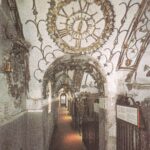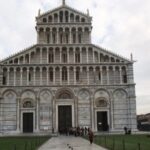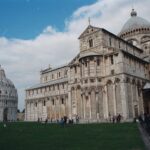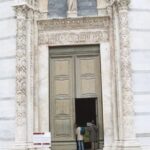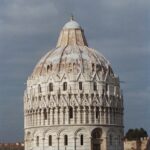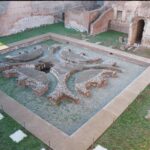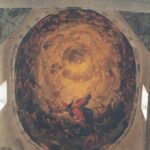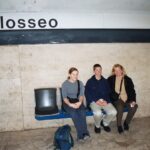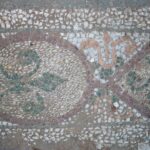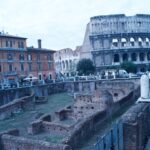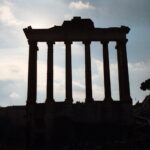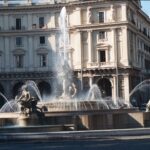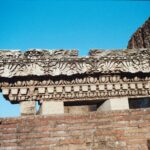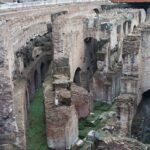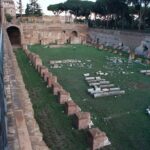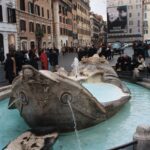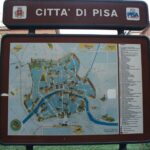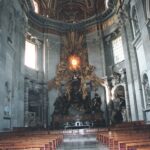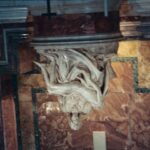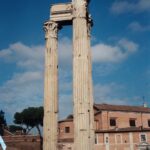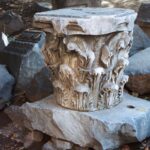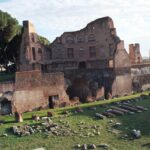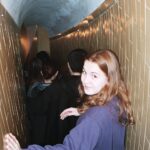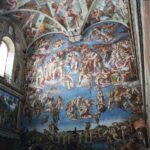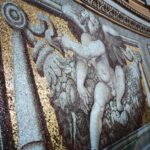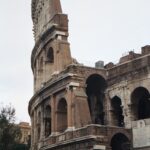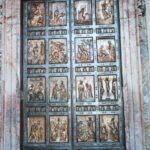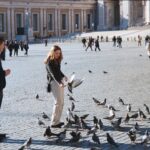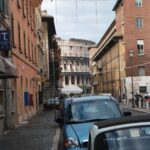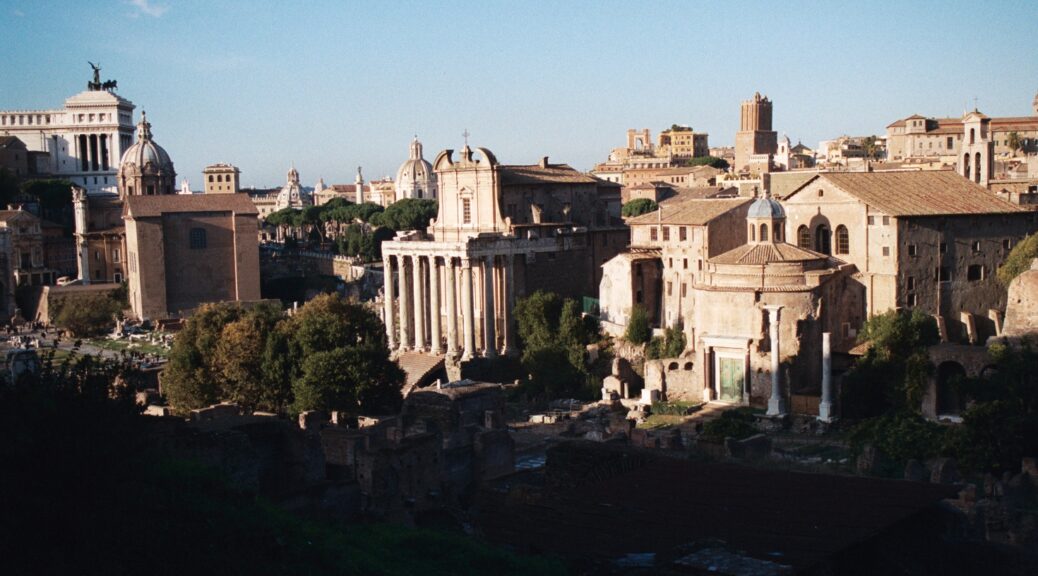
Rome
Rome! The eternal city.
We booked a 6-night package, from November 20 to the 27th, through Go-Today. We booked September 11th, 2001 around 0800 CST. We didn’t know it, of course, but the first plane hit the tower just minutes earlier.
We kept our trip plans but when we flew to Rome on November 20th, the plane only had about a dozen people on it.
We traveled with Alex’s friend, Shane, and his mom, Dee. We picked them up and drove to Chicago for our flight to Philadelphia and then our overnight flight to Rome.
We arrived in Italy at 0840, 1340 central time, on November 21st. Our tour included airport transfers, so we had a car waiting to take us to the Hotel Napoleon. We dropped off the bags and caught a taxi to Vatican City for the open Papal Audience they have every Wednesday.
After, we did a little shopping as we walked down the street looking for the metro and had lunch. We took the wrong bus but saw a lot of the city on our little “detour”.
Although it took us a while to find our way back the first day, the hotel was conveniently located steps from a subway stop, the Vittorio Emanuele, and just up the hill from the Colosseum and another metro stop. The rooms were nice but the shower was very small and the water temperature went from scalding to freezing and back frequently. The breakfasts were really good and we started every day with some good rolls, cold ham, cheeses, and fresh fruit or yogurt.
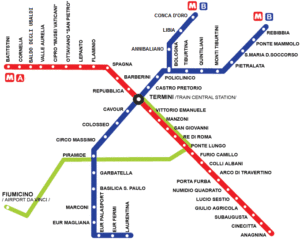
I’ve visited plenty of big cities, but none was quite as difficult to navigate as Rome. It wasn’t the distance although we did walk many kilometers. There were only two subway lines when we were there but another has been added; Line C (green line) was opened in 2014. I remember our concierge saying “every time they try to build a new line, they find more ruins then the archeologists come in and dig with spoons, so nothing gets done”. Even with our maps, the narrow roads and alleys, designed for chariots, multiple intersections off one square, all made the maps very hard to follow and we got lost frequently. A couple times we wandered in circles looking for a specific road to get to a site we wanted to visit, that has never happened to me before, or since.
After hard days of walking around on uneven cobblestones, we relaxed in the nice big lounge. We would pick up some drinks or gelato from one of the little shops down the street and sit around talking and resting our feet. Alex and Shane always wanted some extra slices of pizza, no matter what we had or when we had dinner. The simple margherita pizza was quite delicious. They would play a lot of games, cards and connect four, in the lounge, too.
Vatican City
This Papal Audience, an open assembly, happens every Wednesday. We arrived a little late so sat way back in the auditorium. The Pope was already speaking. A large group of Cardinals were on stage with him. The Cardinals were taking turns, addressing the audience in their native language and welcoming various groups from their home countries.
After each of the Cardinals, the Pope would offer a greeting in the same language. We recognized Italian, German, Spanish, Polish, English, and French. There were several others as well. Some groups brought instruments and played songs or sang when they were introduced. Many others stood and waved scarves and cheered when they were called. It was very festive, not solemn like a religious service. Alex and I are not Catholics, but all of us were very glad we decided to go despite being late.
After the audience, we toured St. Peter’s Basilica, saw the huge altar and “baldacchino”, the canopy over the altar, both designed by Bernini, Michelangelo’s Pieta, and the various chapels. We stopped by to rub St. Peter’s foot for good luck. Alex, Shane, and I climbed the dome. Dee waited for us below as she is a bit claustrophobic and the stairs for the dome wind up between the narrow double walls.
The climb up St. Peter’s dome, the world’s highest, started with an elevator ride. We arrived at the bottom of the dome, inside, for great views of the church. We walked outside onto the roof and had great views of Saint Peter’s Square, the Vatican Gardens behind the church, and all of Rome spread before us. Beautiful! We continued up the narrow, curving stairs inside the dome to the top, the highest point in all of Rome, before going back down to the church.

We wandered all over the huge square, also designed by Bernini, enjoying the columns, statues, the obelisk from Egypt, the fountain, and art. The square is one of the world’s largest, it can hold 300,000 people.
Later in the week, we returned for our 9:30 reservation to see the “scavi’’ or excavations under St. Peter’s. You have to book this months in advance but it’s worth the planning. The tour was for 15 and above. Both Shane and Alex were 14, our visit was several months before their birthdays. With a few back and forth emails, we got permission from the the tour operations at Saint Peter’s for them to visit before we left home, fortunately.
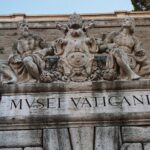 We had an excellent guide, Cordelia. Multi-lingual, she clearly loved her job and loved showing off the amazing excavations, telling us about the 2000 years of history cut into this hill, and Saint Peter’s burial and tomb. This was a highlight of our week.
We had an excellent guide, Cordelia. Multi-lingual, she clearly loved her job and loved showing off the amazing excavations, telling us about the 2000 years of history cut into this hill, and Saint Peter’s burial and tomb. This was a highlight of our week.
We only had a couple hours to see the Vatican Museums because we had reservations to see Galleria Borghese and we rushed through to see the Sistine Chapel. Michelangelo’s ceiling and Last Judgment are as spectacular as I expected, the crowds were more than I expected. I was surprised they let this many people in at once. It was wall to wall people and very noisy. Every bit of the room is painted. I was even impressed with the lower walls, painted to look like cloth, with delicate shadowing.
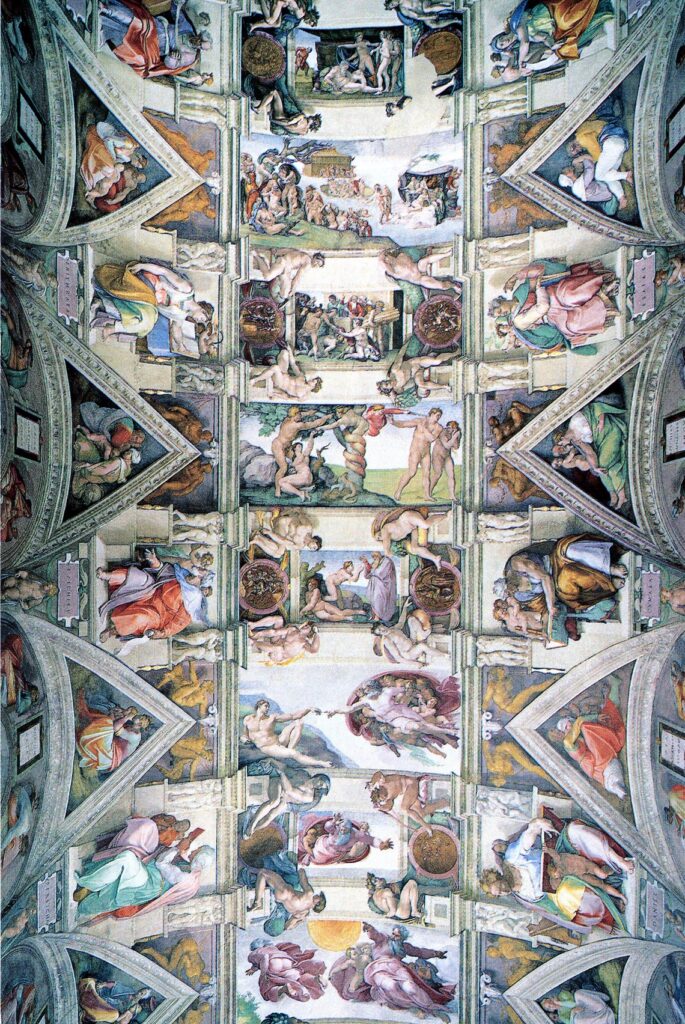
After leaving the chapel, we enjoyed the rest of the museum for an hour and a half, seeing the great maps in the Galleria delle Carte Geografiche, and many other statues and paintings and beautiful rooms. After rushing through, in order to make it to Galleria Borghese on time, we got lost on the way and missed our reservations.
Ancient Rome: The Roman Forum and the Seven Hills
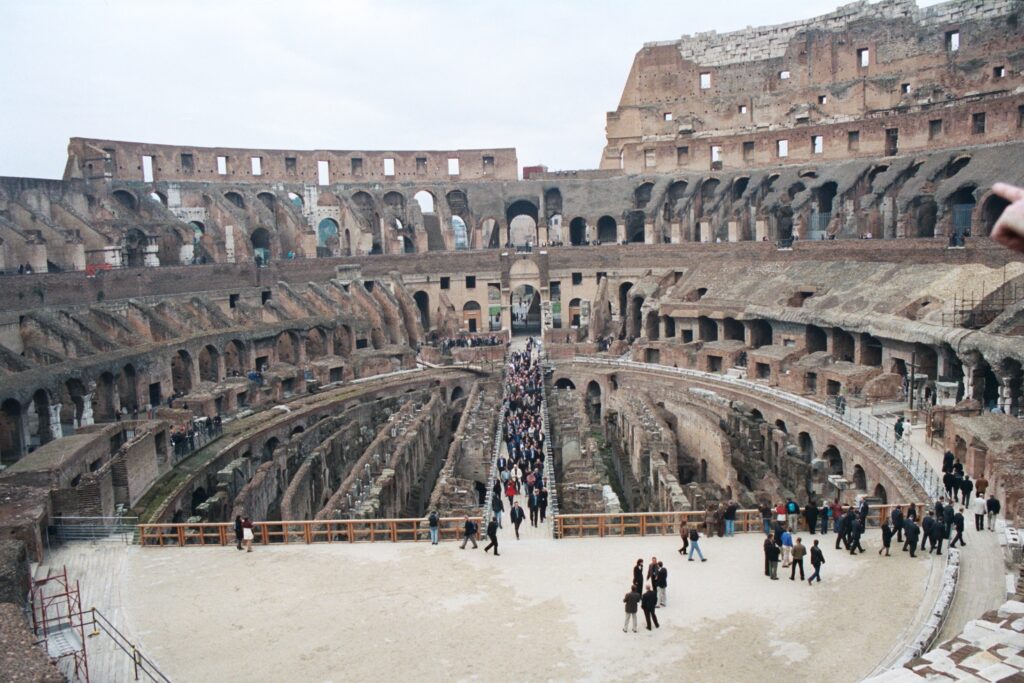
From our hotel, we walked down the hill to the Colosseum and bought a special combination ticket; it included the forum and Palatine hill. Looking online in 2022, tickets have to be booked in advance. We spent about an hour touring the amphitheater, which is amazing. Many parts are open to explore including much of the underground area where slaves, gladiators, and animals were kept. We also saw the Ludus Magnus, the largest of the gladiatorial schools in Rome, just east of the Colosseum.
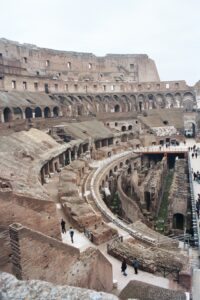
The Roman Forum was the center of public life in the city for centuries. It was the site of elections, public speeches, and commercial affairs for the city. It is absolutely amazing to walk through here, even in ruins, it’s beautiful, incredible buildings all around.
We saw the old Senate building or Curia, the Temple of Vestal Virgins, the Temple of Castor and Pollux or Tempio dei Dioscuri, and the Arch of Titus. We also saw the Basilica of Maxentius and Constantine, or Basilica di Massenzio, the largest building in the forum and the last Roman basilica built in the city. We learned that “basilica” was a large public building used for courts and other official town functions. Much later it became the name for a large church with similar design. We saw the Tempio di Antonio e Faustina, an ancient Roman temple later converted to a Catholic Church, San Lorenzo in Miranda.
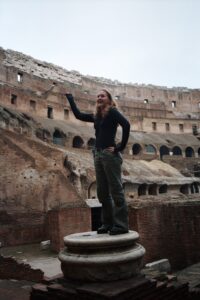
Palatino, or Palatine Hill, was the cradle of Roman civilization; it is thought to be the original settlement. It even predates the Roman Forum. We visited after leaving the forum, walking through a garden of orange and cypress trees. It was here that, according to legend, Romulus and Remus were raised by a wolf and founded Rome. Ruins, as far back as 900 BCE have been found. The Palatino was considered a prime residential site for over 1000 years. The Republic’s prominent citizens all lived here, including Agrippa, Cicero, Catullus. Augustus was born here and built a huge palace. It was hard to see where all the various buildings were, even with our guide books but we enjoyed this very much. It was so peaceful, with very few people and one of my favorite things in Rome.
We visited Palazzo Massimo or Palazzo Massimo alle Terme. Along with the Baths of Diocletian, they are part of the National Roman Museum. The palace or villa is “Neo-Renaissance style” built between 1883 and 1887. It was used as a Jesuit college until 1960 and in 1981 it became part of the National Roman Museum. It is considered to have one of the best archaeological and classical art collections in the world. I loved the great mosaics and statues.
The Termi di Diocleziano, or baths of Diocletian, were commissioned by the Emperor Diocletian. The baths had a capacity of over 3,000 people, the largest in Ancient Rome. Construction began in 298 and they were completed in 306. Made of bricks, covered in marble and decorated in mosaics and sculptures, the complex included a gymnasium, library, and hot and cold baths. They remained open until 537 CE.
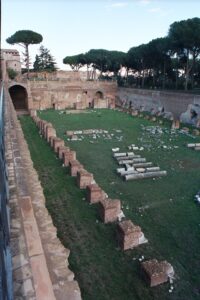
In the valley between the Palatine and Aventine hills in Rome, the huge “Circo Massimo” could hold 300,000 people who came to watch the chariot racing. Started around 326 BCE, it was used until 549 CE. Augustus Caesar built his imperial palace on Palatine Hill, with balconies overlooking the racecourse. The area was surrounded by shops, taverns, and arcades to serve the crowds.
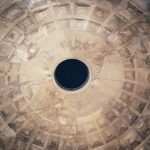
After lunch on the steps outside the Metro stop, Alex and Dee bought our Nero House tickets.
We walked downtown and saw the Pantheon before our visit. This gorgeous building is in an equally gorgeous setting on the Piazza della Rotonda. The Pantheon is one of the best preserved of all ancient Roman buildings; built between 119-128 by Hadrian. It was for the “most holy” Olympian gods, pan theos or all gods. Hadrian rebuilt the temple of Agrippa that was destroyed by fire, around 126 CE. It has been a Catholic Church, Saint Mary and the Martyrs, since 609 CE. The 30-foot hole in the dome allows in sunlight but was designed to link the earthly temple to the heavens.
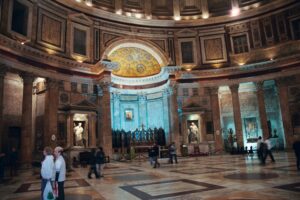
Domus Aurea or Nero’s Golden House, I missed this while reading my guide book but Dee added it to our ‘must see’ list. No pictures were allowed and they didn’t even have postcards to buy of the interior. This huge, fantastic place was still being excavated and guided tours with advanced reservations were required. Same day tickets were available, though. Nero started his palace after the great fire of 64 BCE leveled large portions of the city. He appropriated huge areas of Rome for his proposed home and it eventually spread over a quarter of Rome, covering the Esquiline, Palatine and Coleian Hills. Close to the palace was an artificial lake with a 115 foot statue of Nero. Worked stopped when Nero died in 68 CE and later emperors demolished large portions of it. The lake was drained and the Colosseum was built on the site. The palace was covered with Trajan’s baths. The site was rediscovered in 1490.
We made a mistake thinking it was truly a “guided” tour but the guide just escorted us through, making sure we didn’t damage anything but didn’t provide any information. We rented a couple of audio guides however and shared them. The size of the rooms, the frescoes, the paintings on the walls were amazing. We saw dozens of rooms, dining rooms, halls, bedrooms, and didn’t realize how far we had walked into the ruins, since we stopped repeatedly on the way, until we left and had to walk to the exit. This was only a small portion of Nero’s “Golden House” and it was immense.
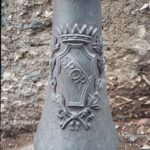
SPQR: Senatus Populusque Romanus, or the Senate and people of Rome, we saw this symbol everywhere. Shane and I had fun pointing it out to Alex, on paving stones, grates, sewer covers, and lamp posts. It really annoyed Alex at first, but soon Shane and Alex had a little SPQR dance they would do whenever they saw the symbol.
Churches and Fountains and Piazzas
We caught the metro to the Spagna stop to see the Spanish Steps. Their real name is Scalinata della Trinita dei Monti or steps to the church of Trinita dei Monti, but everyone knows them as the “Spanish Steps”. They link the Piazza di Spagna to the church above the plaza and were named for the Spanish ambassador who lived here.
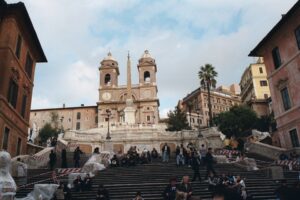
One Italian we met called them Rome’s living room; hundreds of people are always here just sitting on the steps or around the Barcaccia Fountain or “Fountain of the Worthless Boat”, designed by Pietro Bernini and his son, Gian Lorenzo.
The Capuchin Crypt is located beneath the church of Santa Maria della Concezione dei Cappuccini. It contains the skeletal remains of 3,700 bodies believed to be capuchin friars buried by their order across six rooms. They include the “Crypt of the Skulls”, “Crypt of the Pelvises”, “Crypt of the Leg Bones and Thigh Bones”, and more. The crypts contain monks who died between 1528 and 1870. The crypt was started back in 1631, when the Capuchin monks moved into their new friary upstairs and brought with them the bones of their brothers. They arranged these bones in their new crypt, just lining them up against the walls, but eventually getting much more elaborate and using them in designs. The bones, such as skulls, leg bones, pelvises and such, were separated and used to make columns, arches, and other designs. Supposedly, a reminder of our own mortality, but regardless of the motivation, it is very weird seeing all those bones of monks used as decorations, altars and even chandeliers. The soil in the crypt is from Jerusalem. No photos were allowed when I visited but I purchased some postcards. However, there are many, many photos found online.
After visiting the church, very plain compared to the other churches in Rome or its elaborate crypts, we walked downtown to see the Trevi Fountain. It is beautiful at night. It doesn’t seem as big as in pictures but seeing the Trevi Fountain is still impressive. We sat for a while enjoying the sound of the water and watching all the people. It’s a beautiful site and popular with couples. We had some gelato across the street before heading back to the hotel.
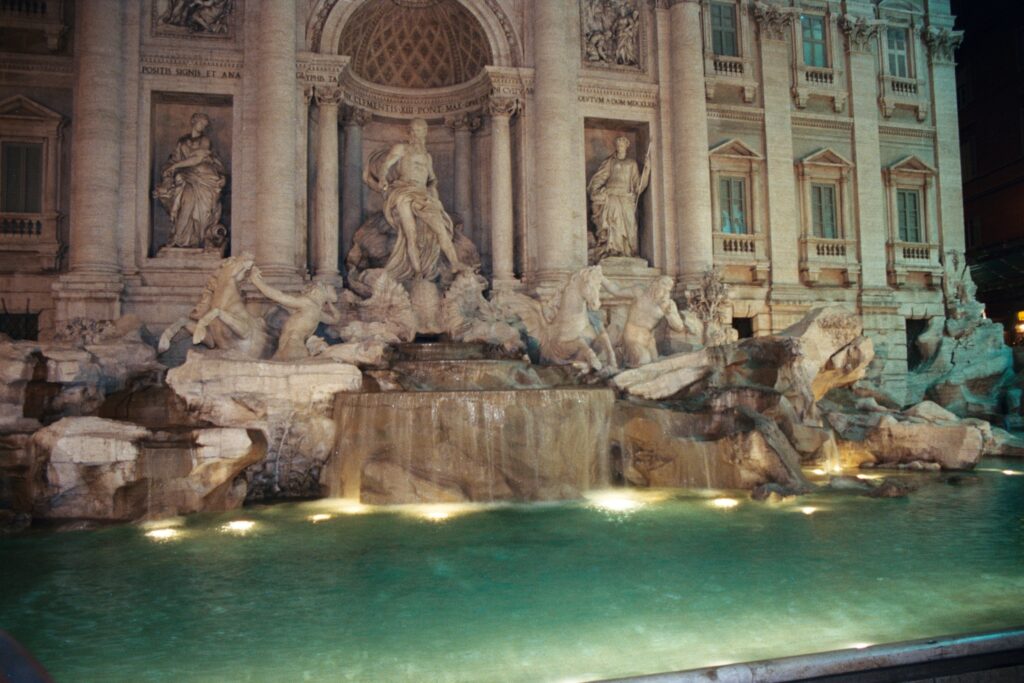
We saw the Fontana della Naiadi or Fountain of the Nymphs on the Piazza della Repubblica. It displays sea nymphs entwined in marine creatures tentacles, considered too erotic for the public when first built and remained covered until a massive public protest. We also went to see the Fountain of Neptune in Piazza Navona.
Santa Maria Maggiore was built around 431 AD; mass has been said every day here since the 5th century. It contains beautiful mosaics and the ceiling, completed in the 16th century, contains gold from the “new world”. The high altar has a life sized statue of Pius IX in prayer before 5 pieces of wood, said to be from Jesus’ manger in Bethlehem.
San Clemente was very close to our hotel and Colosseum so we walked there one morning. This is an amazing church and a great example of the long history of Rome. Archaeologically, the structure is a three-tiered complex of buildings:
- The present basilica built just before the year 1100
- A 4th century basilica converted from the home of a Roman nobleman, which served as an early church in the 1st c., and in the 2nd c. served as a mithraeum
- A home of a Roman nobleman built on the foundations of a republican era building destroyed in the Great Fire of 64.

I loved the frescoes in the current basilica, but the 4th century ruins are wonderful. The lowest level is the mithraeum or temple dedicated to the bull god Mithras. We saw a 1900–year–old Roman alley now 33 feet below street level. Excavations continue as they find more Republican era buildings at this level. San Clemente is truly an amazing site and I highly recommend.
Pisa
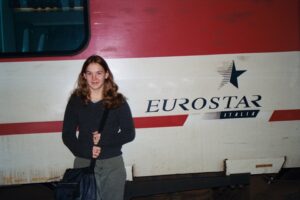
On Monday, we had to get up early, around 5:45 and caught the metro at 6:30 to get to the train station in time for the 7:07 to Pisa. We arrived around 10. The trip on the Eurostar went very quickly.
Pisa is a much smaller town, very enjoyable to walk around. They provided a convenient map of the city right outside the station in Pisa. We didn’t walk in circles and didn’t get lost once. The walk from the train station to the plaza was lovely and we crossed the Arno over the Ponte Solferino. We stopped to see the beautiful Chiesa di Santa Maria della Spina on the way. Built in 1230, named for containing a “spine” or thorn from the crown of thorns, it’s very ornate outside, “Pisa Gothic”, inside it’s one small room.
We had no problem finding our way to the Piazza dei Miracoli or Plaza of Miracles, with the Leaning Tower we had come so far to see. We saw the Tower and took a ridiculous number of pictures, we went into the Cathedral and the Battistero and visited the camposanto, or cloistered cemetery. Alex, Shane, and I climbed the dome in the baptistery. The beautiful baptistery on the Plaza of Miracles, dedicated to John the Baptist, was begun in 1152 and continued about 100 years later by Nicola Pisano. It is the largest baptistery in Italy. The main door (photo below), has pictures of Christ between Mary & John the Baptist surrounded by angels around the upper lintel. The lower lintel has episodes in the life of John the Baptist.
We shopped at the vendors lining the square then stopped for a late lunch on the way back to the station. On the ride back, Alex got caught up on her homework. We arrived back in Rome around 6 pm.
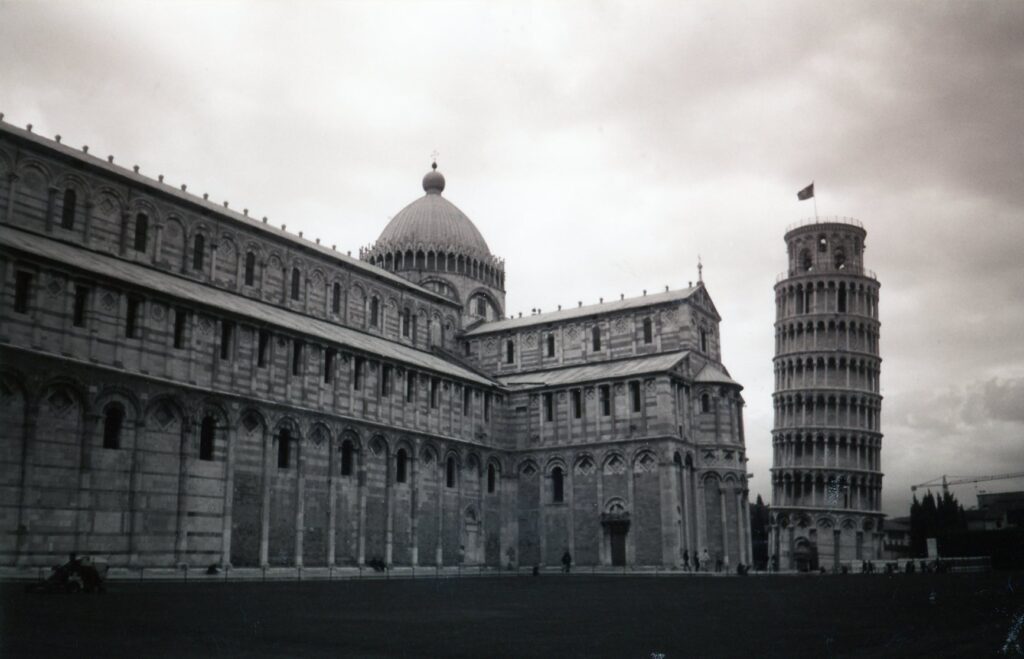
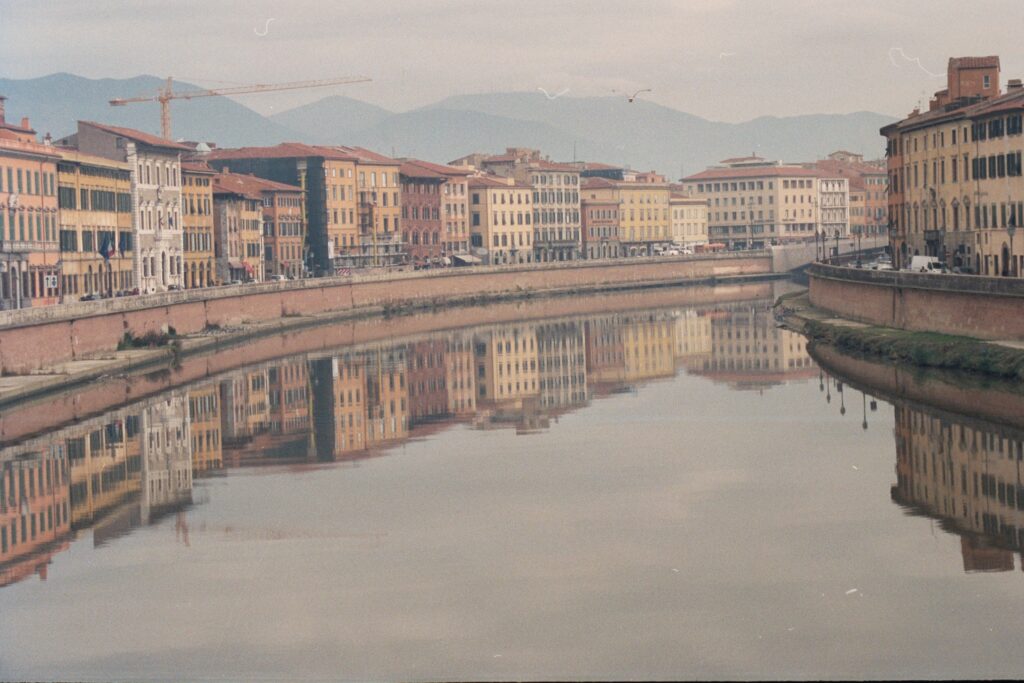
Even though I missed some things I really wanted to see in Rome, I’m very glad we decided to spend a day in Pisa. The train ride gave us a chance to rest our aching feet, those old cobblestone streets are hard to walk on, and we had great views up the coast, seeing the Mediterranean, and islands of Elba and Corsica, too.
Markets and More
After visiting San Clemente we caught the subway to go to Porta Portese, the big Sunday market. We saw San Giovanni di Laterno, old city walls, pyramid of Gaius Cestius, Victor Emanuele monument, and then spent a couple hours at the market. Alex had a wonderful time. I thought it was horrible, very crowded, people pushing on all sides.
Later we caught the metro to Termini and a taxi to the catacombs di Priscilla. CLOSED!! The book said it was open Sundays. Very disappointing. Even more disappointing was the taxi driver, who obviously knew the catacombs were closed. He pulled up to them, slowed down without stopping, “they are closed”, shrugged, and said, “back to town”? Now it’s easier to check current hours online, then we thought our book was accurate and didn’t verify.
So we went back to hotel and out to the same restaurant as Wednesday for more pasta. The food was great, but service not as good.
The food everywhere in Rome was fabulous; we had great pasta, caprese salad, fresh mozzarella, the best pizza, pizza margherita with a great tangy crust, tomato sauce, fresh basil and just a little cheese, wonderful breads, and, of course, the unbeatable gelato. We did go to Hard Rock one night. Dee and Shane wanted to visit, since they had never visited one. Seems a shame to eat that when in Italy (or ever?) but we mostly enjoyed the wonderful Italian food.
On Tuesday, were were up early to finish packing and were picked up at the hotel at 8:15. We spent our remaining lira at airport, on gelato, pizza and drinks. We had a long, a very long, day to get home.
Six days in Rome is not nearly enough. There is so much to see, so much I missed. I could have spent an entire day in the Vatican Museums, they deserve that much time. We missed the Galleria Borghese, any of the dozens of catacombs, Castel Sant’Angelo, many more museums and churches. I want to, hope to, plan to, return for at least another week.
** All photos property of Lisa, except where indicated. Not to be copied or reproduced **
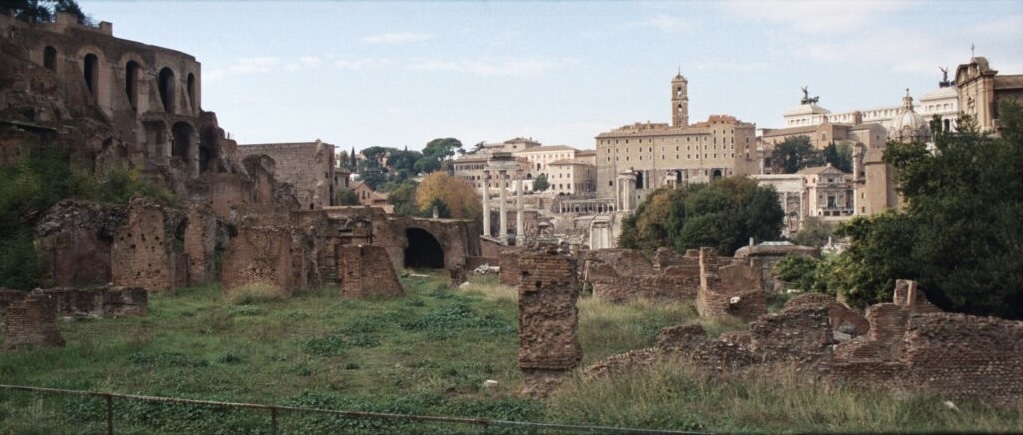
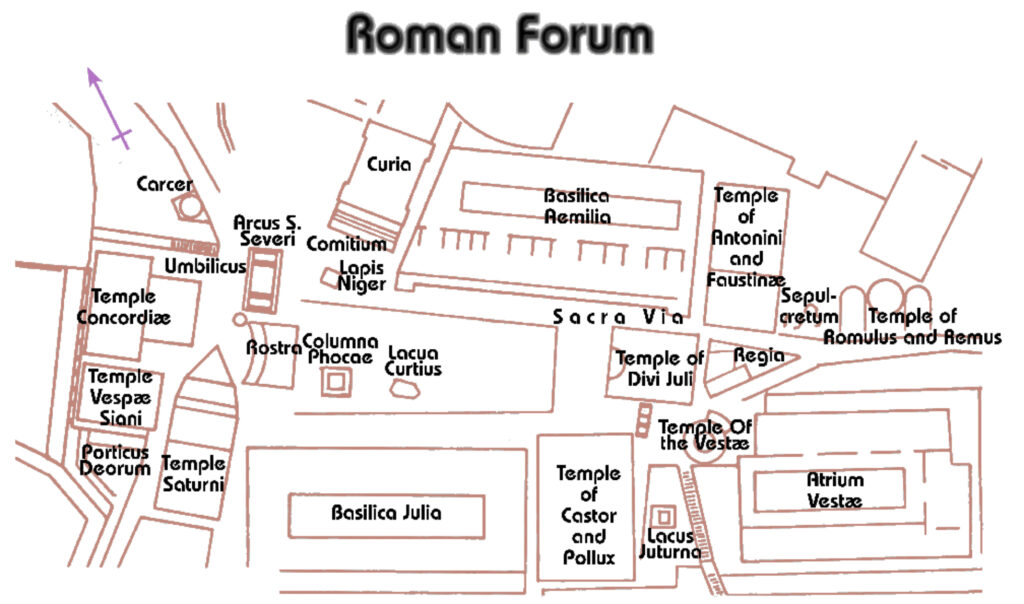
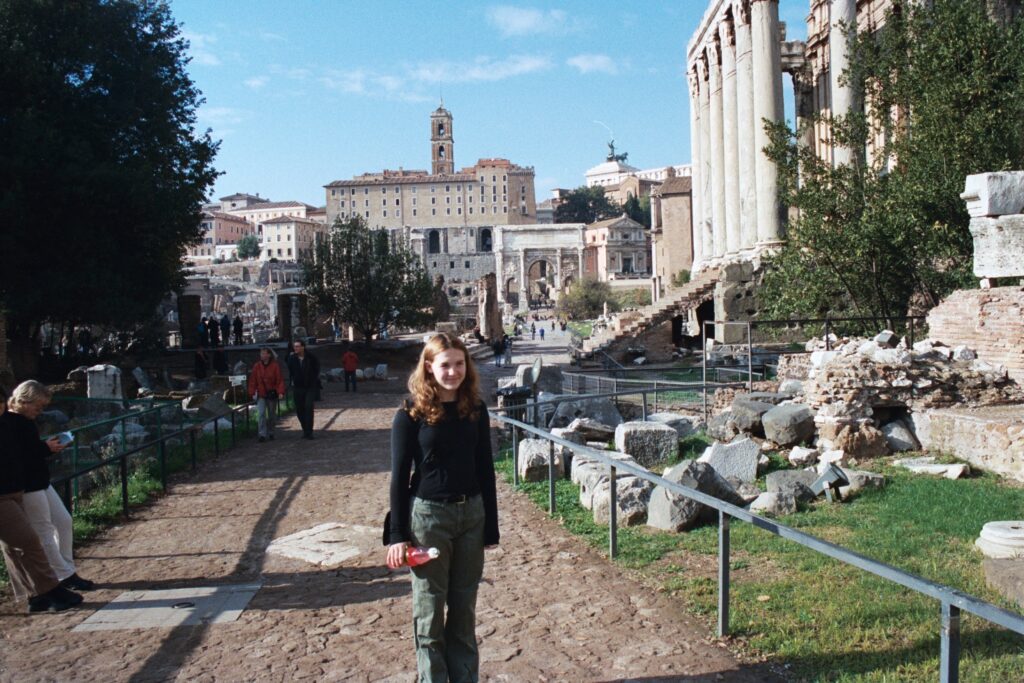
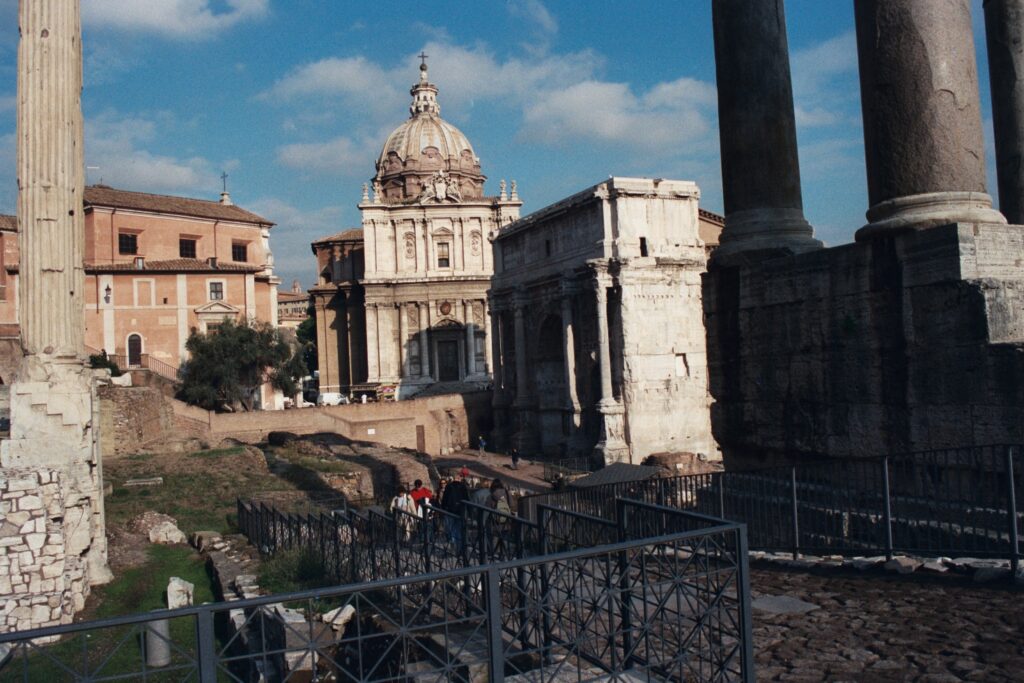
Notes:
September, 11, 2001 terrorists attacked the United States by hijacking four planes and flying them into the World Trade Center buildings in NYC and the Pentagon in Washington. The fourth plane crashed into a field in Pennsylvania due to the heroic actions of some of the people on board, preventing it from crashing into another building in Washington. We had booked our trip to Rome less than an hour before the first plane hit the Towers. For the first time, and I hope the only, I was nervous about flying.
We tried not to think about it too much prior to the trip but it was difficult with all the reports of airline safety and the new security measures on the news. The US began bombing Afghanistan, where the terrorist who planned the attack was living. While we have, or had, a number of allies in what Bush called the “War of Terror”, there were protests around the world, and even in the US on the start of the war. Even in times of relative peace there are always people, in every country, who dislike our country, our government, or its policies. I often dislike government policies myself, including my own objections to this war and the Iraq invasion a few years later. Regardless, for this trip we wanted to keep a low profile. We tried to dress less like “typical” Americans in jeans and white tennis shoes, and instead packed nicer clothes. We found quite a lot of graffiti in Rome showing displeasure with the US and its policies.
